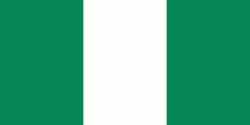Abia State (Abia State)
 |
Abia is the 32nd largest in area and 27th most populous with an estimated population of over 3,720,000 as of 2016. Geographically, the state is divided between the Niger Delta swamp forests in the far south and the drier Cross–Niger transition forests with some savanna in the rest of the State. Other important geographical features are the Imo and Aba Rivers which flow along the Abia's western and southern borders, respectively.
Modern-day Abia State has been inhabited for years by various ethnic groups, but it is predominantly inhabited by the Igbo people. In the pre-colonial period, what is now Abia State was a part of Arochukwu-based Aro Confederacy before the confederacy was defeated in the early 1900s by British troops in the Anglo-Aro War. After the war, the British incorporated the area into the Southern Nigeria Protectorate which later merged into British Nigeria; after the merger, Abia became a centre of anti-colonial resistance with the Women's War that started in Oloko.
After independence in 1960, the Abia was a part of the post-independence Eastern Region until 1967 before the region was split and it became part of the East Central State. Less than two months afterwards, the former Eastern Region attempted to secede in the three-year long Nigerian Civil War with Abia as a part of the secessionist state of Biafra. At the war's end and for the reunification of Nigeria, the East Central State was merged as one until 1976 when Imo State](including now-Abia) was formed by the Murtala Muhammed regime. Fifteen years afterwards, Imo State was divided with eastern Imo being broken off to form the old Abia State; but in 1996, part of Abia's northeast was removed to form a part of the new Ebonyi State.
Economically, Abia State is based around the production of crude oil and natural gas along with agriculture, mainly of yams, maize, taro, oil palm, and cassava. A key minor industry is manufacturing, especially in and around Aba. With its fast growing population and industrialization, Abia has the joint-eighth highest Human Development Index in the country.
Abia State occupies about 6,320 square kilometres, it us bounded on the north and northeast by the states of Enugu, and Ebonyi. Imo State to the west, Cross River State and Akwa Ibom State to the east and south east respectively, and Rivers State to the south. The southernmost part of the State lies within the Niger Delta Swamp Forests, while the rest of the state, lies within the Cross–Niger transition forests. The southern portion gets heavy rainfall of about 2400 mm per year and it is intense between the months of April through October. The most important rivers in Abia State are the Imo and Aba Rivers which flow into the Atlantic Ocean through Akwa Ibom State.
Map - Abia State (Abia State)
Map
Country - Nigeria
 |
 |
| Flag of Nigeria | |
Nigeria has been home to several indigenous pre-colonial states and kingdoms since the second millennium BC, with the Nok civilization in the 15th century BC, marking the first internal unification in the country. The modern state originated with British colonialization in the 19th century, taking its present territorial shape with the merging of the Southern Nigeria Protectorate and Northern Nigeria Protectorate in 1914 by Lord Lugard. The British set up administrative and legal structures while practising indirect rule through traditional chiefdoms in the Nigeria region. Nigeria became a formally independent federation on 1 October 1960. It experienced a civil war from 1967 to 1970, followed by a succession of military dictatorships and democratically elected civilian governments until achieving a stable democracy in the 1999 presidential election. The 2015 general election was the first time an incumbent president failed to be re-elected.
Currency / Language
| ISO | Currency | Symbol | Significant figures |
|---|---|---|---|
| NGN | Nigerian naira | ₦ | 2 |
| ISO | Language |
|---|---|
| EN | English language |
| HA | Hausa language |
| IG | Igbo language |
| YO | Yoruba language |















